Copper and its principal architectural alloys are relatively active metals which, when left unprotected, tend to oxidize (weather). Long term atmospheric exposure generally results in the formation of the naturally protective gray-green patina.
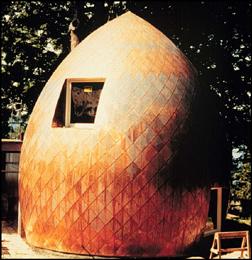 Because copper and its alloys afford a broad spectrum of both natural and weathered colors, much effort is expended to either hasten the natural weathering by chemical means or to preserve the bright natural colors through the application of clear protective coatings.
Because copper and its alloys afford a broad spectrum of both natural and weathered colors, much effort is expended to either hasten the natural weathering by chemical means or to preserve the bright natural colors through the application of clear protective coatings.
Natural Weathering
Chemical Coloring
Clear Coatings
Opaque Coatings
Natural Weathering
The natural weathering of copper to the characteristic blue-green or gray-green patina is a direct consequence of the mild corrosive attack of airborne sulfur compounds.
As natural weathering proceeds, the metal exposed to the atmosphere changes in hue from the natural salmon pink color through a series of russet brown shades to light and dark chocolate browns and finally to the ultimate blue-green or gray-green patina.
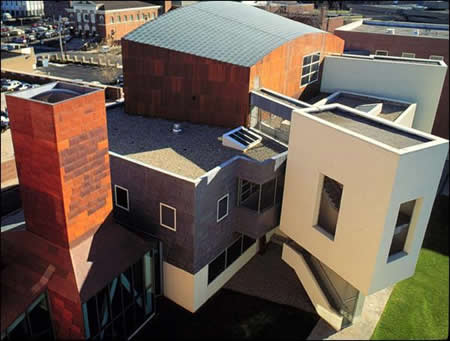
Click here to view Copper Weathering Chart.
During the initial weeks of exposure, particularly in a humid atmosphere or in areas of frequent rainfall, radical color changes often take place with iridescent pinks, oranges and reds interspersed with brassy yellows, blues, greens and purples. During continued exposure, these interference colors fade and are replaced by relatively uniform russet brown shades referred to as statuary or oxidized finishes.
Due to varying fabricating procedures, some mills may coat coiled or flat sheet stock with a thin coat of anti-stain oil film. This film may give rise to dark purple or black surface colorations soon after installation and exposure. This is a temporary color phase caused by the thin oil film, which is quickly washed off by rain allowing the natural weathering of copper to proceed.
In industrial and seacoast atmospheres, the natural patina generally forms in from five to seven years. In rural atmospheres, where the quantity of air-born sulfur dioxide is relatively low, patina formation may not reach a dominant stage for 10 to 14 years. In arid environments, the basic sulfate patina may never form due to the lack of sufficient moisture. Similarly, exposed horizontal surfaces develop the patina more rapidly than sloping surfaces which, in turn, patinate more rapidly than vertical surfaces. The critical variable, in all instances, is the dwell time of moisture on the exposed surfaces.
The progressive oxide, sulfide and sulfate films which develop on copper exposed to the atmosphere are quite thin two to three thousandths of an inch highly adherent, but with relatively low abrasion resistance. Neither the oxide nor sulfide films are particularly corrosion resistant. The sulfate patina, on the other hand, is highly resistant to all forms of atmospheric corrosion, once it has had an opportunity to form completely. It thus significantly increases the durability and, hence, the service life of copper roofing and flashing. The natural weathering cycle of copper is illustrated by the 12 sequential color plates in the Weathering Chart.
Although the plates represent a typical sequence, the weathering of any installation will depend on local environmental factors, orientation and amount of residual lubricants.
The weathering of copper will reach a final equilibrium with its local environment. This state of equilibrium is very stable and no further weathering will occur after this state is reached. However, the final equilibrium color will vary depending on orientation, slope, and local weather conditions.
Chemical Coloring
Because of the time required for copper to weather to the ultimate blue-green or gray-green patina, men have sought for centuries to hasten the process by chemical means.
Coloring however is an art, mainly a matter of craftsmanship and experience. Chemical coloring techniques depend upon time, temperature, surface preparation, humidity and other variables which influence the ultimate result. A wide range of colored finishes may be produced on architectural copper-base alloys by conversion coatings that are chemical in nature. The purpose is to hasten the natural weathered effect that generally results from exposure to the elements.
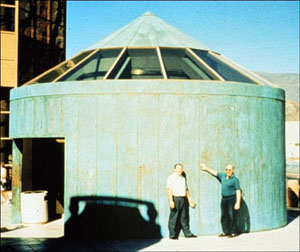
Several conversion treatments are in general use which produce the patinas (verde antiques) and statuary (oxidized) finishes.
Patinas are primarily developed using acid chloride treatments or acid sulfate treatments. Because of the number of variables involved, chemically induced patinas are prone to such problems as lack of adhesion, excessive staining of adjacent materials and inability to achieve reasonable color uniformity over large surface areas. These potential shortcomings should be considered when specifying such treatments. Due to the large number of requests for historical chemical applications CDA has compiled the most prevalently used chemical processes.
Because production of an artificial patina on copper is dependent upon a number of variables, including temperature, humidity, wind velocity, surface condition of the copper and method of application, wide variations in the result achieved have been experienced. Reliability of all present methods can, at best, be considered only fair to poor
The following treatments have exhibited some degree of success:
- Statuary Finish
- a). Ammonium Sulfide base.
b). Potassium Sulfide base.
Green Patina Finish- a). Ammonium Sulfate base.
b). Ammonium Chloride base.
c). Cuprous Chloride/Hydrochloric Acid base.
For specific solution specifications and application procedures see How to Apply Statuary and Patina Finishes, or download the printable PDF (104 Kb).
Factory applied pre-patination systems are continuously being investigated for architectural applications. Contact a CDA Project Managers & Architectural Applications Specialists for updated information on such systems.
See also Pre-Patination Systems.
Clear Coatings
Frequently, it is desired to preserve the original salmon or gold tones of copper or brass surfaces. This can be achieved by applying clear protective coatings. The coatings create a weather barrier and prevent the further oxidation of copper, brass and bronze surfaces. However, as with any coating, degradation over time will require the stripping and replacement of the clear coating.
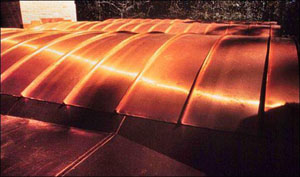
Opaque Coatings
These coatings are used primarily for work applied over copper when substrate integrity and longevity are desired but a specific color other than the naturally occurring copper hues is required.
Paints: Copper is an excellent substrate for a painted finish. Prior to painting, the surface must be free of grease, oil, dirt, fingerprints, drawing compounds and surface passivation treatment chemicals.
A first coat of an industrial wash primer should be applied according to the specific manufacturers recommendation. The finish coat should be two coats of an oil alkyd enamel designed for exterior (or interior) use. Appropriate finish coatings are industrial enamels and silicone alkyd enamels of the specified color.
Gilding: The lamination of very thin gold leaf to copper is a very old tradition. The physical advantages of gold's color and weatherability with copper's sub-surface integrity combine into a very durable, long lived, maintenance free surface. Most gilding is done on historical statuary or domes that are difficult to maintain.
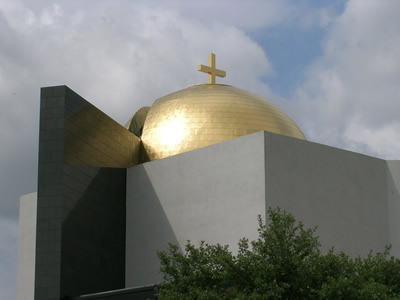
Specifying gilded surfaces includes the following:
| Cleaning | Removal of oil, dirt and any surface oxides. Mechanical etch with fine grit sand paper or acid etch to bare metal. |
|---|---|
| Primer | The application of zinc chromate or VOC compliant primers. Butyl based or moisture cured urethane. Universal metal primer. Two coats. |
| Adhesive | Compatible with the selected primer. Acrylic size or slow drying alkyd resin, catalyzed marine epoxy. |
| Gold Leaf | 18 gr. per 1000 sheets. 23.5-K gold leaf. Applied to dried adhesive. Burnish. |
